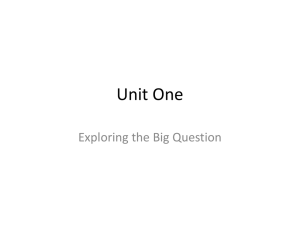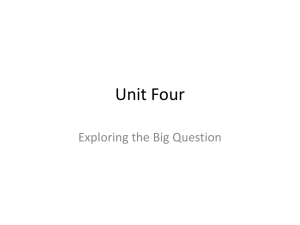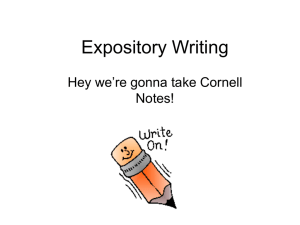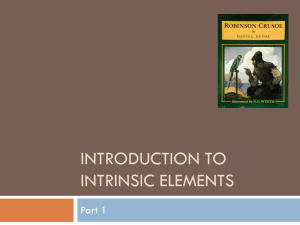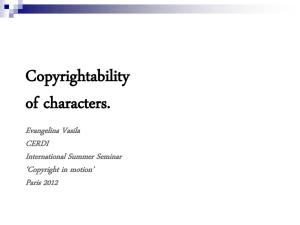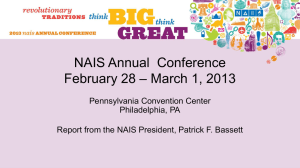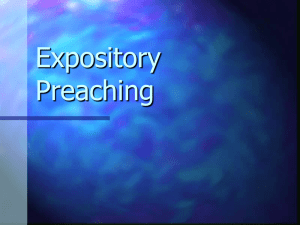Treasures Unit Five Big Question
advertisement
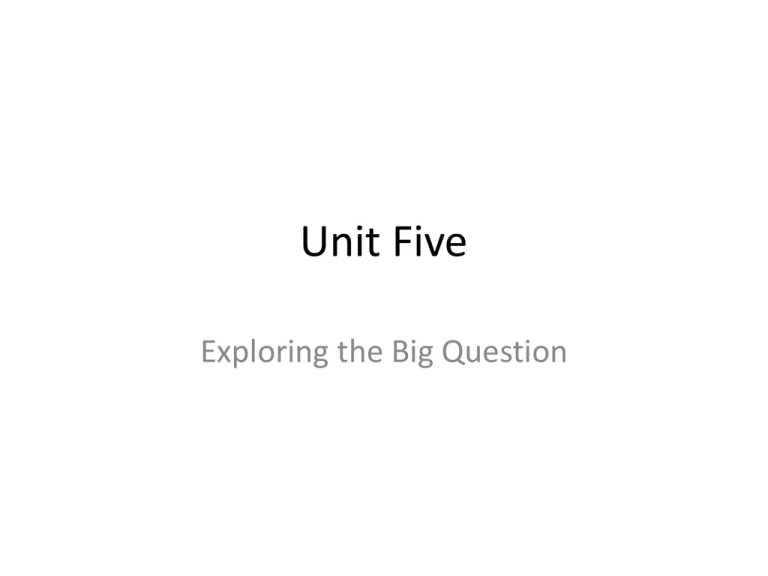
Unit Five Exploring the Big Question “Always dream and shoot higher than you know how.” ~ William Faulkner What brings out the best in you? Quotes for Small Group Facilitated Discussions “If we did all the things that we are capable of, we would literally astound ourselves.” ~ Thomas Edison “When we seek to discover the best in others, we somehow bring out the best in ourselves.” ~ William Arthur Ward “Treat a man as he appears to be, and you make him worse. But treat a man as if he already were what he potentially could be, and you make him what he should be.” ~ Johann Wolfgang von Goethe “It’s not what you are that holds you back, it’s what you think you are not.” ~ Denis Waitley “As human beings, our greatness lies not so much in being able to remake the world - that is the myth of the atomic age - as in being able to remake ourselves.” ~ Mahatma Gandhi “Not everybody can be famous but everybody can be great, because greatness is determined by service.” ~ Martin Luther King Jr. “You were born with potential. You were born with goodness and trust. You were born with ideals and dreams. You were born with greatness. You were born with wings. You are not meant for crawling, so don't. You have wings. Learn to use them and fly.” ~ Rumi “When we do the best that we can, we never know what miracle is wrought in our life, or in the life of another.” ~ Helen Keller “The greatness comes not when things go always good for you. But the greatness comes when you're really tested, when you take some knocks, some disappointments, when sadness comes. Because only if you've been in the deepest valley can you ever know how magnificent it is to be on the highest mountain.” ~ Richard Nixon Look Me in the Eyes Failure Better than Me Reflect: Expository Critique applied to video 2.6 Determine the adequacy and appropriateness of the evidence for an author’s conclusions. 2.7 Make reasonable assertions about a text through accurate, supporting citations. 2.8 Note instances of unsupported inferences, fallacious reasoning, persuasion, and propaganda in text. A Further Exploration of What Brings Out the Best in You As a class, we will read, analyze, and discuss the following pieces in the reading textbook: “A Lesson in Courtesy” by Stan Sakai on p. 584 “Voices from the Holocaust” by Michael A. Schumanon p. 596 “Primary Lessons” by Judith Ortiz Cofer p on p. 607 Peruse the following selections in your reading textbook, and choose three selections you would be interested in reading and discussing in class: “The Secret Schools” by Susan Goldman Rubin on p. 604 “Satchel Paige” by Bill Littlefield on p. 626 “TIME: Gentleman of the Pool” by Alice Park on p. 640 “Eleanor Roosevelt” by William Jay Jacobs on p. 642 “President Cleveland, Where Are You?” by Robert Cormier on p. 664 “The Eco-Canoeist” by Sy Montgomery on p. 684 “Going Blind” by Ray Charles and “Ray Charles” excerpt by Sharon Bell Mathis on p. 692 As you read, you will be thinking about how these stories might relate to the themes of what brings out the best in you, fairness, what makes you who you are, why you read, and what makes a hero. An In-Depth Look at What Brings Out the Best in You A Wrinkle in Time OR by Madeleine L’Engle Crash by Jerry Spinelli Comparing and Contrasting: What Brings Out the Best in You and Authors’ Techniques The Sidewalk Racer Lillian Morrison Skimming an asphalt sea I swerve, I curve, I sway; I speed to whirring sound an inch above the ground; I'm the sailor and the sail, I'm the driver and the wheel I'm the one and only single engine human auto mobile. Alone in the Nets Arnold Adoff Ode to Mi Gato He's white As spilled milk My cat who sleeps With his belly Turned toward The summer sky. He loves the sun Its warmth like a hand. He loves tuna cans And milk cartons With their dribble Of milk. He loves Mom when she rattles The bag of cat food, The brown nuggets Raining into his bowl. And my cat loves Me, because I saved Him from a dog, Because I dressed him In a hat and a cape For Halloween, Because I dangled A sock of chicken skin As he stood on his Hind legs. I love mi gato, Porque I found Him on the fender Of an abandoned car. Gary Soto He was a kitten, With a meow Like a rusty latch On a gate. I carried Him home in the loop Of my arms. I poured milk Into him, let him Lick chunks of Cheese from my palms, And cooked huevo After huevo Until his purring Engine kicked in And he cuddled Up to my father's slippers. That was last year. This spring, He's excellent at sleeping And no good At hunting. At night All the other cats In the neighborhood Can see him slink Around the corner, Or jump from the tree Like a splash of Milk. We lap up His love and He laps up his welcome. Assessments: Words of Week weekly vocabulary test A Wrinkle in Time or Crash comprehension tests Accelerated Reader reading, vocabulary, and literary analysis test Treasures Unit 5 Assessment on pp. 716-720 Discussion of what brings out the best in you and reflections on inner strength and the implications for one’s own life Optional if needed: Treasures individual story assessments and Treasures formative assessments to define differentiation Standards Embedded: 1.0 Word Analysis, Fluency , and Systematic Vocabulary Development Students use their knowledge of word origins and word relationships, as well as historical and literary context clues, to determine the meaning of specialized vocabulary and to understand the precise meaning of grade-level-appropriate words. Word Recognition 1.1 Read aloud narrative and expository text fluently and accurately and with appropriate pacing, intonation, and expression. Vocabulary and Concept Development 1.2 Identify and interpret figurative language and words with multiple meanings. 1.3 Recognize the origins and meanings of frequently used foreign words in English and use these words accurately in speaking and writing. 1.4 Monitor expository text for unknown words or words with novel meanings by using word, sentence, and paragraph clues to determine meaning. 1.5 Understand and explain “shades of meaning” in related words (e.g., softly and quietly). 2.0 Reading Comprehension (Focus on Informational Materials) Students read and understand grade-level-appropriate material. They describe and connect the essential ideas, arguments, and perspectives of the text by using their knowledge of text structure, organization, and purpose. In addition, by grade eight, students read one million words annually on their own. Structural Features of Informational Materials 2.1 Identify the structural features of popular media (e.g., newspapers, magazines, online information) and use the features to obtain information. 2.2 Analyze text that uses the compare-and-contrast organizational pattern. Comprehension and Analysis of Grade-Level-Appropriate Text 2.3 Connect and clarify main ideas by identifying their relationships to other sources and related topics. 2.4 Clarify an understanding of texts by creating outlines, logical notes, summaries, or reports. 2.5 Follow multiple-step instructions for preparing applications (e.g., for a public library card, bank savings account, sports club, league membership). Expository Critique 2.6 Determine the adequacy and appropriateness of the evidence for an author’s conclusions. 2.7 Make reasonable assertions about a text through accurate, supporting citations. 2.8 Note instances of unsupported inferences, fallacious reasoning, persuasion, and propaganda in text. 3.0 Literary Response and Analysis Students read and respond to historically or culturally significant works of literature that reflect and enhance their studies of history and social science. They clarify the ideas and connect them to other literary works. Structural Features of Literature 3.1 Identify the forms of fiction and describe the major characteristics of each form. Narrative Analysis of Grade-Level-Appropriate Text 3.2 Analyze the effect of the qualities of the character (e.g., courage or cowardice, ambition or laziness) on the plot and the resolution of the conflict. 3.3 Analyze the influence of setting on the problem and its resolution. 3.5 Identify the speaker and recognize the difference between first- and thirdperson narration (e.g., autobiography compared with biography). 3.6 Identify and analyze features of themes conveyed through characters, actions, and images. 3.7 Explain the effects of common literary devices (e.g., symbolism, imagery, metaphor) in a variety of fictional and nonfictional texts. Additional Standard Embedded in Poem of the Day: 3.4 Define how tone or meaning is conveyed in poetry through word choice, figurative language, sentence structure, line length, punctuation, rhythm, repetition, and rhyme. Expository Critique 2.7 Make reasonable assertions about a text through accurate, supporting citations. Additional Standard Embedded in novel study: Literary Criticism 3.8 Critique the credibility of characterization and the degree to which a plot is contrived or realistic (e.g., compare use of fact and fantasy in historical fiction).

